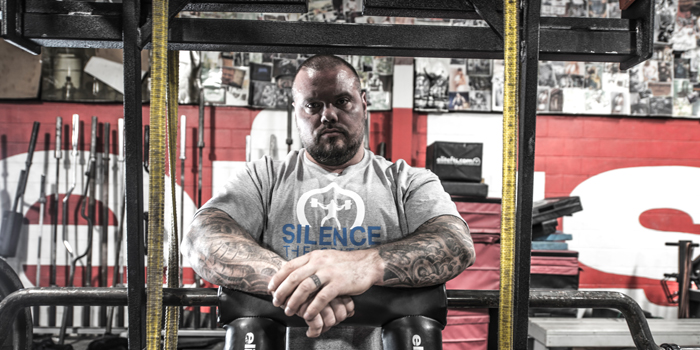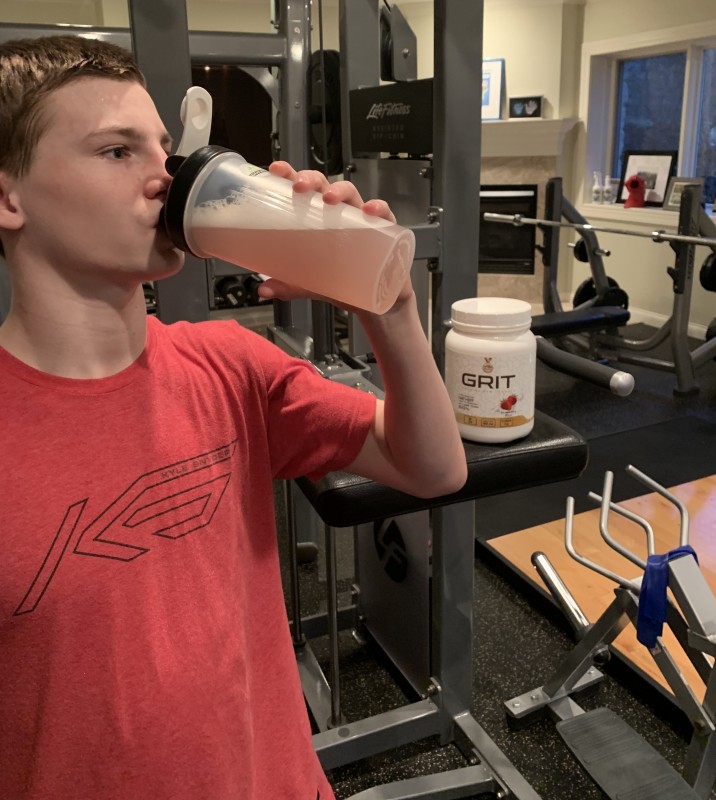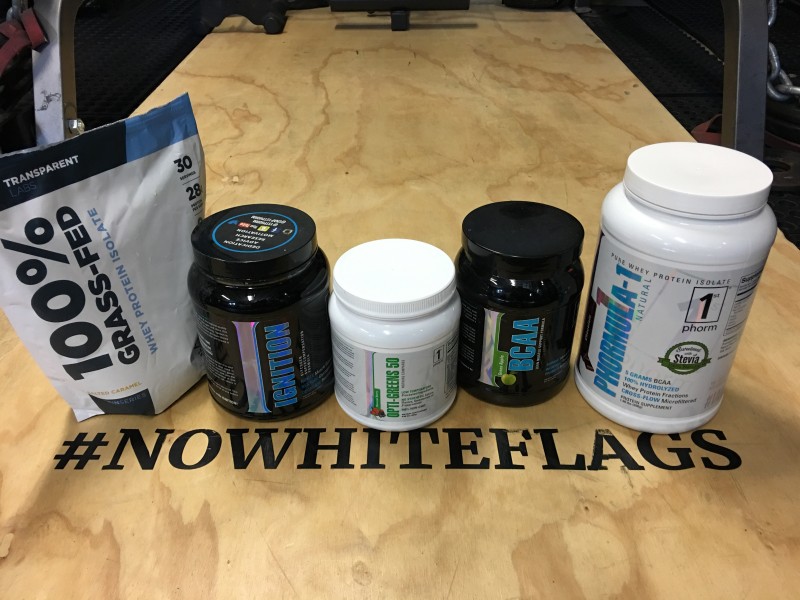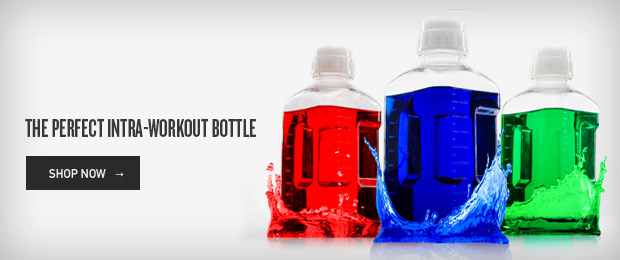
In Part 1 of my BAMF Wrestler series, I gave you a glimpse of a detailed year-round wrestling training program I’ve been developing with my friend, colleague, and Strength N Honor Training Facility’s head strength and athletic conditioning coach and owner Steve “Kono” Konopka. We talked about the challenges we’ve seen in modern wrestling programs, training frequency, and the importance of letting kids be kids.
In Part 2, Kono and I talked more in-depth about our in-season training goals, off-season exercises to avoid, recovery sessions, favorite exercises, and a sample in-season schedule.
In Part 3, Kono and I covered our daily pre-practice warm-ups, bulletproof shoulder circuits, what we call the “f@#k the bottom, you belong at the top” conditioning circuit, and answered a couple of questions.
In this fourth and final installment, we discuss post-match recovery, supplement suggestions, and refueling tips.

What are some of the ways you suggest to your athletes to help recovery post-match or post-tournament?
KONO
We try to make sure the athletes know recovery starts right after the match. Duals and tournaments are a little different in the way you can refuel. Dual matches are a little easier; they are only one match and for most of our #BAMF wrestlers 90 percent of the time, it’s over pretty quick. Hydration, refueling, and cooldown should begin immediately post-match before they sit back down and start cheering for their teammates. At dual matches, you can put down more calories and not have to worry about foods not digesting before your next match.
Keeping it simple with a bottle of Body Armor, mixed with a scoop of whey isolate protein and a Kind Bar or granola bar is a great start and easy to have while you're sitting on the bench.
For the next meal, I like seeing some more carbs and protein that are whole food options: a small half portion of brown rice, whole-wheat pasta, or medium sweet potato with a few ounces of chicken or steak. I like adding some coconut oil or olive oil for some healthy fats and a pinch of Himalayan salt. This meal, in my opinion, should be kept between 250 to 400 calories, depending on the athlete’s weight and cutting.
For tournaments, it is a little different because you want to keep wrestlers hydrated and replenish their glycogen in-between matches with quick digesting carbs. In tournaments, replenishing must be quick to digest and small in the most effective portions possible.
Wrestlers do not need a bellyful of food during a match; it is actually very counterproductive. A full belly of food means blood is being utilized in the digestion process and less goes to the muscles, where it is needed to perform. Body Armor or meathead lemonade sipped, not chugged, to stay hydrated are great options.
Here are a few options for tournament days that our wrestlers use with success:
- Apples
- Go-Go Squeeze Applesauce
- Cucumber sticks
- Pretzel sticks
- Bananas
- Chobani yogurt
- Kind Bars
- Rx Bars
Snacks throughout the day between rounds should be eaten in small portions or a few bites.
Post-weigh-in refueling is really important, especially if you had a tough weight cut or really dehydrated yourself to make weight. That can always be avoided with planning and proper nutrition, but we won’t go there right now. One of my favorite post-scale refueling tricks is to use the meathead lemonade with BCAA.
I learned about this concoction from Joe DeFranco years ago and added the BCAA to it as well. It works great and should be drunk the second you step off the scale! Body Armor is another option. There's also Pedialyte, and the last option would be your typical sports drink.
Next is our Strength N Honor Sweet Potato Smash:
- Using a large sweet potato (NOT A YAM) the night before, boil, bake, or microwave it until fully cooked.
- Cut the sweet potato in half and gut the insides into a container. You want to make sure you mash it to a baby-food-like texture.
- Add about 2¼ teaspoons of ground pink Himalayan salt — NOT regular table salt! Pink Himalayan salt has 84 trace minerals and electrolytes your body needs to re-hydrate.
- Add 3 tablespoons of organic real maple syrup or 3 tablespoons of raw local honey.
- A couple of dashes of cinnamon.
- Mix all together until completely blended and you have baby food texture again.
- Cover and put into the fridge.
Once you get off the scale for weigh-ins drink half of your meathead lemonade and eat a third to a half of your sweet potato smash.
Relax and get dressed for 10 to 15 minutes to let it settle in your stomach. Get a light stretch or foam roll in for 10 minutes or so. Drink the other half of the lemonade and have one or two small bites of your sweet potato smash. Start your normal routine for warming up for the tournament.
Typically, wrestlers will drink fluids the rest of the tournament, based on thirst and sweat. There should be four to six small bites left of your smash and you can take a bite after each round, or if there are a few hours of layoff until finals, finish it an hour before.
Always try any new foods, drinks, or supplements prior to tournaments or games. That way you see how your body reacts and feels on it. You may need to adjust your timelines depending on how your body digests the nutrients. But these are good guidelines of what our wrestlers typically do and are options for you to consider when planning your refueling routine.
CHRIS
Post-match or post-tournament meals can vary, but you want something that digests rapidly and will replace glycogen with a moderate insulin spike. The meal can also vary based on your overall carbohydrate intake through the entirety of the day.
For someone that ingests a large number of carbs daily, they will want to do something that allows for a large influx at this point that sits light on the stomach. These next few samples are something that former Mr. Ohio Marc Snyder showed me years ago. To this day, I still follow and recommend it.
For the wrestler who is calorie-restricted or in a dieting phase, they can take a whey isolate or lean white protein with white rice. For a wrestler who doesn’t have trouble making weight or is not over their respective weight class, they can eat a higher calorie dense meal such as a whey isolate with a rice-based cereal. This is a little more fun than a traditional carb powder. These rice products usually do not cause any gastrointestinal issues.
Nutrient uptake during this period of the day is crucial, and we do not want to disrupt the system. This is not to say that other items cannot be used, though. It is very dependent on the athlete, their needs, goals, and demands placed on their body.
Another great option post-weigh-in and 30 minutes before a match or before every other match at a tourney is GRIT. Just add 30 grams to some water. It’s all you would need to feel better and recover quicker. GRIT will provide you with the correct dose of potassium, magnesium, and BCAAs to reduce your muscle fatigue to a minimum.
GRIT will also hydrate you with five times more electrolytes than the world's leading sports drink. GRIT is formulated to absorb three to four times faster in your body than water alone due to the simple (dextrose) and complex (maltodextrin) quality carbs you’ll find in GRIT and the sugar in the form of glucose, your energy level will increase when you’re training and competing.

What are some supplements that you suggest for wrestlers that help maintain strength and health and boost recovery?
KONO
First things first, we always try to ensure that most of our athletes’ nutrients come from whole food sources. The demand of wrestling, more than any other sport, in my opinion, really makes it hard to utilize whole foods, especially when you talk about the average high school athlete. When you factor in weight cuts, the intensity of training, and convenience, supplements are usually a must for high-level wrestlers.
A good protein powder is a must in my opinion. Unlike other athletes who can just have a steak, chicken, or turkey breast, a wrestler may not have the room for any extra calories while trying to make weight. Add the fact of easier digestion and transportation like school or away tournaments, protein powder is a convenient option to ensure quality nutrition. A high-quality whey isolate that ensures rapid digestion is what I would recommend.
Another great option for wrestlers is a mixed greens powder. I feel this product is super important for the wrestler cutting weight to ensure they are getting proper nutrients for health and immune system. Though the mixed greens powder cannot replace all fruits and vegetables, it does provide a ton of nutrients and phytonutrients that may be missing in a calorie-restricted athlete.
BCAA is another staple in our wrestlers’ nutrition. BCAA allows a zero-calorie option to help speed recovery and works to keep the athlete out of a catabolic state to help preserve muscle.
Those three are my top recommendation for wrestlers. You can go a little further with a vitamin C and or a vitamin B complex because both will help the athlete boost their immune system and help with energy production.
A lot of the wrestlers in the heavier weights who have the luxury of trying to maintain their weight in-season have added creatine, which I think is a great supplement for athletes at the appropriate time in their athletic career. I do not recommend creatine while having bigger weight cuts unless you really have experience using it and know exactly how your body retains weight-wise while on it.
Top Three Supplement Suggestions
- Whey protein isolate (all natural grass-fed)
- Mixed greens (organic)
- BCAA (with electrolytes)
Added Suggestions for Optimal Health
- Vitamin C
- Vitamin B Complex
CHRIS
Eating healthy well-balanced meals is key for any athlete, especially a wrestler. One has to feed the machine constantly. For wrestlers who make huge weight cuts, this can be tricky. It is best to eat properly year round, so if you must cut, it won’t destroy you. With this being said, here are a few of my recommendations for supplements.
- Protein powder
- GRIT (Recovery and rehydration drink)
- Vitamin C
- Multi-vitamin
I believe a great amount of protein is needed for wrestlers. I would say around 0.8 to 1 gram of protein per pound of the wrestler daily is good. This would be hard to do from food only daily, especially after a practice or dual/tourney. Slamming a shake will help with this, as it is convenient and a lot easier to transport than real food.
We spoke some about GRIT earlier, but I should include it has the supplement beta-alanine and beetroot powder.
Beta-alanine will help increase your muscle endurance in high-intensity exercises and will aid in faster recovery by flushing the lactic acid out of your muscles.
The beetroot powder is a superfood that improves exercise stamina.
Supplementing some extra Vitamin C is always a great idea. There are numerous benefits to this, but the one I like the most is the boost of the immune system, which is especially important for the wrestler who wreaks havoc on their body.
Taking a multivitamin daily is another smart move for the wrestler. Obviously, you would want to get most, if not all, vitamins from food, but when cutting weight is a factor and not eating as much happens, a multivitamin can help.
Any suggestions for speeding up recovery post-match or post-tournament? Besides refueling, what tips do you give your wrestlers to help them start the recovery process?
KONO
I would love it if the teams would do a five- to ten-minute cool down for the team, but it’s a tough request. It is usually up to individual athletes to take the cooldown process into their own hands.
A good five-minute fast walk, slow jog, or exercise bike workout are great ways to help to flush out lactic acid and bring the heart rate down from a long, tough match. Another few minutes of foam rolling post-match is also beneficial.
I really like wrestlers being able to get some type of body tempering in when they can. Body tempering was developed by Donnie Thompson, but you can see the old-school Soviet Union/Russian wrestlers from decades ago walking on each other before practice and after workouts. I think they really could see the recovery process being sped up by the force being applied to the soft tissue and muscles. Wrestlers who do some type of body tempering once a week, especially toward the end of the season, seem to stay fresher and feel better mentally.
Ice tubs or contrast tubs work great, even if the athlete can do just one a week. At the end of the day, it’s really on what is available to the athletes. Financially and time-wise, some of the options may be out of the question for your typical high school athlete. However, ice tubs, slow jogs, and foam rolling of some sort should be automatic.
CHRIS
Ice therapy or an ice tub works best. Most know about this recovery method. However, most don’t utilize it. Almost everyone loves how fresh they feel after the addition of ice. This will reduce inflammation and help the body recover quicker.
There are many different theories and studies, but what I have found best with 10 to 15 minutes in a hydrotherapy tub or a simple bathtub. Both options would be full of ice and cold water. The main difference between the two would be that the hydrotherapy tub motor is pumping a constant flow to the tub and the bathtub water is stagnant.
After 10 to 15 minutes in the ice tub, take a warm shower, a contrast (cold/hot or hot/cold/hot, etc.), which is another ideal form of recovery. The cold water constricts the blood vessels and decreases blood flow. Then the warm/hot water dilates your blood vessels while increasing blood circulation.
Another popular option today is cryotherapy. I have personally never done a session but have heard positive feedback from some. A downfall with this is the price. It can get very pricey compared to the old fashioned way described above.
Another good recovery method is a common-sense method but one some don’t do — sleep. Mentally and physically, one needs a great night sleep.
There have been numerous studies over the years proving this. As an athlete, it is always best to get eight or more hours per night and more is always better. Turning off phones, TV, and all distractions is a must. If you can, throughout the day try to take a quick nap as well. I find that even a 15- to 20-minute nap helps me feel better and more refreshed.
This summer, keep an eye out for the #BAMFW eBook: a 12-Week Strength and Conditioning Training Manual to Turn You Into A #BAMFW! To get more release updates and more tips to becoming a BADA$$ MOTHER$&@¥ING WRESTLER, follow us on Instagram.
Remember: there is only room for one at the top of the podium, and they are a #BAMFW!
Steve “Kono” Konopka can be emailed at strengthnhonorgym@gmail.com, and Chris Janek can be emailed at tankstrainingfacility@yahoo.com. They are also available on social media outlets at Strengthnhonortraining and tankstrainingfacility, respectively.










